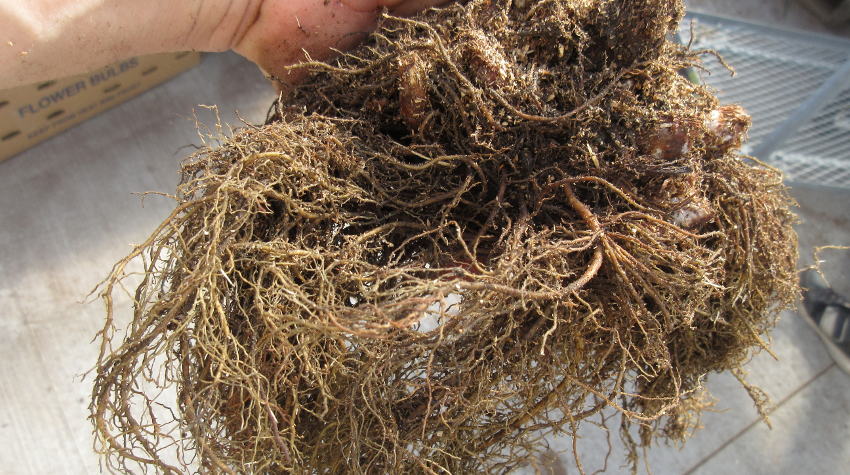Almost every Internet article, school course, or piece of friendly advice says to break the roots of a plant when you plant it. But is that really the right thing to do?
Years ago, I did my horticulture apprenticeship here in Ottawa and got the same spiel: always break apart the roots when planting. But the more I think of it, the more I don't quite understand the whole concept.
First of all, roots are how plants feed. They absorb water and nutrients through the roots. The parts that pull up that water are the most fragile hairy feeder roots than can die incredibly quickly, even when just exposed to enough sun for a few minutes to dry out their surface. Get some clunky gardening gloves on there shifting stuff around and many of those fragile feeder roots are damaged or destroyed and need to re-grow. Growing roots takes time, just like it takes time for a scratch on your arm takes to heal. And we're told to do that when we take a plant and move it from one location to another when it's already stressed and needs to adapt to it's new home? Questions abound.
So I think back to where I learned most of what I know about plants: my dad. He did his apprenticeship back in Germany and Sweden. I can't recall one time when he ever broke apart plant roots when planting. Nor can I ever remember him telling me to break apart or loosen the roots. In fact, he always said don't disturb the roots. He always said, if you even take the burlap off the root ball of a tree, that's a sure way to kill it. Most of the time, he was right. When we get people who come to us a few days after planting a trees saying it's dead, most of them removed the burlap contrary to the planting instructions we give with every tree we sell.
Then came some even more evidence in the greenhouse. When I was young, all the flowers were seeded in "open" trays without any division between the plants. It was an art to seed just perfectly to keep those seeds adequately spaced. The plants were then gently pulled apart, disturbing the roots, then planted again into an open tray with more space. When planted in the garden, again plants separated and roots pulled apart. All those marigolds we transplanted during March Break by hand were ready to go the middle of May - eight weeks from transplant to recovery and then growing on. May plantings took a few weeks to establish and the garden was ready by mid-June.
Enter the "plug tray" where every seed gets it's own individual cell, every plant it's own private paradise, and every plant can be moved without ever disturbing the roots. Plants get put into "cell packs" where, again, every plant has it's own private space without any roots ever being disturbed. The result? Transplant a plug gently without ever disturbing the roots and it's recovered, growing, and ready in just four weeks. Four weeks. Sometimes less. Put that into the garden without disturbing the roots and you can see it growing by the end of May. That's less than half the time to recover from transplanting. I'm starting to see a trend here.
When tree and shrub production was in it's infancy, plastic pots weren't readily available, instead they were fibre based and wouldn't last more than a season. Shrubs were grown in the field so everything was dug, potted, and then planted the same year. Roots were disturbed and cut when digging, though in the nursery minimizing that was always a priority - rather contradictory to common teaching. Failure rates on re-planting in the garden were a good 10-20% simply because the plant couldn't absorb enough moisture with it's damaged roots to survive. With the advent of plastic pots, "container grown" became the norm where plants spend at least one full year in the pot, sometimes their entire life. No breaking the roots. No disturbing the roots. Survival rates? 96-98% on average. And I would wager a good portion of those 2-4% are from roots being broken apart when planting.
Now the theory behind disturbing the roots is to make sure they're not one solid mass and don't spiral around in the pot enough to choke itself. OK, I get that. Good theory. Practical? I'm not sure. Plants are more resilient than that. The majority of time, I see roots naturally spread and fan out when a plant gets transplanted and I see it happen faster when they aren't disturbed. From plug to pot, I see new roots grow 2"-3" in a week after planting. On the flip side, I see plant deaths or excess stress weekly from roots being disturbed but I can't even remember the last time I've seen a plant actually girdle itself to death from it's own roots.
So I'm going to go out on a limb and break every school teaching, every bit of Internet advice, and all those theories that abound in North American and tell everybody one thing: Don't touch the roots. Pop the plant out of it's pot as gently as you can by flipping it upside down, put it in it's new home as fast as you can, put new media around the roots without disturbing them, and water right away. Your plants will be happy. They will survive.
Literally millions of plants have passed through these hands in my life, and in my dad's life, and in the whole horticultural industry following that process. It's what we the producers do to bring all those plants to your garden. We can't all be wrong.

